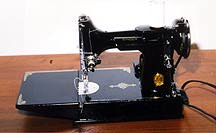|
The same sad tale happens again and again: a group of talented individuals join together with the goal of creating something more than they were capable of alone. They find success, but with success comes disillusionment, anger, resentment and, yes, pies. So it was for a group with some of the most famous names in rock: Barrett, Waters, Mason and, um, that other one. The names behind Pink Floyd. Except this isn't about them. It's about their mums. Tonight on... VH1's BEHIND THE STITCHING It started out innocently enough. Mary Waters and Winifred Barrett took the train together from Cambridge to London to attend the concert by their sons' new band, and Winifred has brought along a few scraps of material to work on during the long ride. She was making a quilt, and Mrs. Waters took great interest in it--she had done a little quilting in the past, but had sort of let it slip out of her life when young Roger had appeared. The care required for the boy's nose alone ate up hours that Mary could have spent with her beloved quilts. But Mary never complained.
"There wasn'a time for it! I was too busy with the washing and waxing of that honker of his. Lovely boy, you know, but it did take him some time to grow into that thing. It was all I could do to keep it clean and shiny." As the train chug-a-chugged its way through the English countryside, the widows Waters and Barrett chatted ever-so-politely about the finer points of quilting--cross-grain binding, basting techniques, thread weight, pattern adaptation, stimulants, proper cloth, and even the "taboo" topics like mixing stripes with plaids. There was an immediate bond, and the two women knew it. Upon arrival in London, the two found themselves feeling a bit out of place at their boys' psychedelic rhythm and blues concert, but they noticed a pair of similarly out-of-place matrons across the hall, one discreetly covering her ears. These turned out to be the mothers of the band's organist and drummer, and after proper polite introductions the foursome slipped out to a nearby tea room for a quiet talk. After the initial pleasantries about their respective children and the lovely outfits each woman had picked out for her boy, there was an awkward silence. A long silence. Long. Really long. Like, you can't even imagine how long it was it was so incredibly long. And not one of those "every seven minutes, there's a lull in conversation" silences. This was epic. At any moment, each woman would turn to the other and expect her to speak, but no one did. It's amazing that they didn't go mad just waiting. All those present would recall later how painfully long of a silence it really was. "Ten minutes, eighteen seconds," recalled Mrs. Wright. "So?" Fortunately, Mrs. Mason spied Mrs. Barrett's patchwork samples protruding from her bag. Between conspicuous sips of Darjeeling tea, Mrs. Mason pointed and coughed. And at last the silence was broken. Yes, all four shared an interest in quilting, and they hit it off quite well, sharing ideas and discussing quilting all afternoon and into the evening. No more awkward silences for them, no sir. Not a one. In fact, you couldn't get them to shut up if you shoved a scone down their throats. The following weekend, the Cambridge contingent made their way to London once again and the four ladies worked on their individual quilts and topped it off with tea and scones. Which they never ate, what with all the talking and all. Before long the ladies were combining their efforts and collaborating on quilts. Mrs. Barrett was the most talented block designer, and although she encouraged the others to suggest their own designs it was she inevitably controlled the matter. Mrs. Wright, a trained seamstress, provided a good deal of technical expertise, while Mrs. Waters and Mason were content to hone their skills by working on Mrs. Barrett's ideas. Once they started entering some of their quilts in local county fairs and craft shows, they knew they were on to something big. Soon they were darlings of the flourishing London Handicrafts scene. Their quilts were featured at a number of County Fair 'happenings', including the "Pinochle and Bridge for May" event, the legendary "2-Hour-Some-Technicolour-But-Largely-Drab-Earth-Tones-and-Tweeds Dream", and "Late Afternoon Tripper" at the famed U Foe Crafts Mart in Twaddlepiddle, Kensington. Before long, the ladies were spending so much time that they barely saw their families. "Oh, poor Roger was just not taking proper care of his nose at the time," says Mrs. Waters. "It was getting quite dirty. He had... pimples! I... blame myself. Why, one day he came home just grimy and I had to use a belt sander." Mrs. Wright had her own concerns. "I assisted the boys with their beautiful clothing ensembles, and without me around, they just got filthy. There was one piece that just broke my heart. I was the one who designed that lovely gay number for Rick, you know with the flowers. "What? What's so funny? I... It was simply gorgeous. Fabulous even! Ricky loved it. He said all the other boys were jealous, and I was so busy with the quilts that I didn't even notice all the stains and fag burns... What?!?" The group had hit the big time, or so these four English housewives thought. But even then, signs of trouble had started. Someone at one of the fairs introduced Mrs. Mason to pie. Mrs. Wright tried espresso for the first time. "It was at a social, you know: a party. It seemed harmless. Everyone else was drinking it. And I found that it helped me stay awake for long marathon sessions of quilting." Mrs. Barrett saw it different(ly). "She brought in these huge, sprawling quilts where the stitch-work just went everywhere. All over the sodding place. It was like a roadmap drawn by a dope fiend. Still, it was such lovely fabric that we hated to throw it out." The women found themselves getting more creative with their quilting. Mrs. Barrett was always pushing new ideas on the group, mostly, she says, to cover for the shoddy workmanship of Mrs. Mason and Wright. Mrs. Waters was a diligent seamstress, but lacked the technical know-how of pre-caffeine Mrs. Wright. Still, she tried.
Soon came the national and international exposure. The ladies were approached by renowned crafts agent Bernice Fitzwallace, who wanted to sign them to a management contract. "They really had," says Fitzwallace, "you know, um, a kind of, you know... thingy. You know what I'm talking about? They just had this... stuff, you know... "money" that I thought I could, um, you know... steal. And stuff." Fitzwallace was, at that time, perhaps best known for her promotion (and eventual bankruptcy) of Lady Eunice Parker-Sheffield, known for her breathtaking series of macrame wall hangings, and was considered by industry insiders to have the best eye for promoting (and profit-skimming) up-and-coming craftswomen. Fitzwallace's guidance paid off almost immediately, as one of their works was featured on the March 1967 cover of the South England Quilt Lover Magazine. They followed this media triumph with a special quilt commissioned for the 2nd guest bedroom of the Mayor of London's sister's summer home in Dover. And although the quilt itself was seen by a relatively small number of people (two--the Mayor's sister and her husband, though technically three if you count the blindfolded Moroccan boy, or four if you count the photographer), the commission generated quite a lot of public interest and buzz in the trade journals, not to mention a minor frenzy among the local journalists at the Dover Telegraph-Post (though they were later found to be plagiarizing from the West Dover Sun-Times-Dispatch-News). Still, many of the ultra-hip wags in the crafts community wondered if the group was losing touch with its roots, and murmurs of "sell out" were heard. The skeptics and naysayers were authoritatively sent packing by the ladies' next move--a sweep of the "Quilting, Candlemaking, and Canned Vegetables" category at the Haltfordshire County Fair. This cemented the group's stature as pop-handicrafts stars, and soon travelling exhibitions of their quilts were breaking all previous records for quilting crowds on the Continent. A quilting show in Oxnardshireville drew more than eight people. (Official tally was nine, though the figure was disputed by Fitzwallace, whose unofficial count was fourteen billion.) But success weighed heavily upon the group, and those closest to the group feared the worst. "Oh, yeh. I feared that," says close friend Sandra "Sandy" Dayoconna. "So did Bob, me husband. We were closest to them at the time. We were lending Fitzwallace a lot of money at the time to help with 'travel expenses,' which was strange, cos we never went anywhere. Had to take out a second mortgage on the kids, we did." Mrs. Barrett was the accepted 'leader', having provided nearly all of the creative inspiration for the quilts. She was, it seemed, starting to crack under the pressure, turning to stronger and stronger teas for stimulation. Some of the group's followers added to the problem by encouraging Mrs. Barrett to try one tea or another, and Mrs. Wright had begun experimenting with lattes. Inevitably, the strain began to affect their work. At a photo session with one of their quilts, Mrs. Barrett refused to answer the questions posed by a reporter from Seamstress Monthly, and finally ended up stripping nude, to the delight of the editor, who soon adopted a controversial "All Nude Seamstress" direction. Mrs. Barrett's stitching became erratic and loose, and the others found themselves forced to cover up her increasingly shoddy work. Even her pattern design was affected, and the others grew frustrated when during one sewing session she kept changing the direction of the binding mid-stitch. Despite their best efforts, the others couldn't follow her changes, and that particular quilt had to be abandoned entirely. Finally, it became obvious that Mrs. Barrett was frankly too far gone. "She showed up at sessions, hopped up on tea, without her needles or fabrics," says a perturbed Mrs. Waters. "It was absurd. Mrs. Fitzwallace was charging us per quilting session, after all, so when she couldn't work, it wound up costing us when she pulled these stunts." "I think the last straw was when she had 'a vision' of having a quilt form-fitted around her entire body," Mrs. Waters says. "So that she could 'be one with the quilt.' We nixed that idea pretty quick, but I don't think she ever recovered fully. The loopy wench." Mrs. Barrett's behavior had become unbearable. At one point, Mrs. Waters suggested to the others that they try to do a quilt on their own, without inviting Mrs. Barrett to help. The others, however, had grown tired of the whole affair by this point. Mrs. Wright was sick of hearing Mrs. Waters go on and on about "her Eric" and his untimely death, and then Mrs. Waters tried to convince Mrs. Mason to vote Mrs. Wright out of the group. Mrs. Mason ultimately admitted that she could see that she was never going to be any good at quilting stuff anyway, and wanted to devote more time to baking pies. They spoke briefly of inviting Gladys Beck, mother of famed guitarist Jeff Beck, to join the group, in hopes that she might provide some much needed stability, but nothing came of it. Finally, with Mrs. Barrett cracking up, Mrs. Waters and Mrs. Wright not speaking to one another, and Mrs. Mason in the kitchen, the group's unfinished work was abandoned, and they effectively disbanded. They still gather occasionally for the odd tea time chat, although Mrs. Wright's is strictly decaf since she got out of the Betty Ford Clinic, and Mrs. Barrett drinks hers through a straw. The silences are more awkward than ever. They discuss the weather, and politely brag on one another's sons. But they never, ever mention quilts, or the glorious triumphs of days gone by. Mike McInnis and Patrick Keller are staff writers for Spare Bricks.
|

 Welcome
my son... welcome to the machine
Welcome
my son... welcome to the machine 
